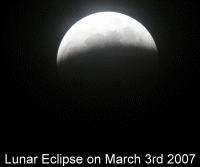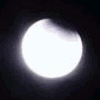Lunar eclipse: Difference between revisions
→External links: Rm, per WP:EL |
m The image sequence has no place at the start of the article. Moved it to the gallery section. |
||
| Line 1: | Line 1: | ||
| ⚫ | |||
[[Image:Lunar Eclipse.svg|right|280px|thumb|Schematic diagram of the shadow cast by the earth. Within the central [[umbra]] shadow, the moon is totally shielded from direct illumination by the sun. In contrast, within the [[penumbra]] shadow, only a portion of the sun is blocked.]] |
[[Image:Lunar Eclipse.svg|right|280px|thumb|Schematic diagram of the shadow cast by the earth. Within the central [[umbra]] shadow, the moon is totally shielded from direct illumination by the sun. In contrast, within the [[penumbra]] shadow, only a portion of the sun is blocked.]] |
||
[[Image:Lunar eclipse diagram-en.svg|280px|thumb|As seen by an observer on earth, the Moon crosses the ecliptic every orbit at positions called nodes twice every month. When the full moon occurs in the same position at the node, a lunar eclipse can occur. These two nodes allow two to five eclipses per year, separated by approximately six months. (Note: Not drawn to scale. The Sun is obviously much larger and farther away than the Moon.)]] |
[[Image:Lunar eclipse diagram-en.svg|280px|thumb|As seen by an observer on earth, the Moon crosses the ecliptic every orbit at positions called nodes twice every month. When the full moon occurs in the same position at the node, a lunar eclipse can occur. These two nodes allow two to five eclipses per year, separated by approximately six months. (Note: Not drawn to scale. The Sun is obviously much larger and farther away than the Moon.)]] |
||
'''February 20, 2008 - Winnipeg, Manitoba, Canada - Total Lunar Eclipse''' |
|||
A '''lunar eclipse''' occurs whenever the moon passes through some portion of the Earth’s shadow. This can occur only when the [[Sun]], [[Earth]], and [[Moon]] are aligned exactly, or very closely so, with the Earth in the middle. Hence, the Moon is always [[full moon|full]] the night of a lunar eclipse. The type and length of an eclipse depend upon the Moon's location relative to its [[lunar node|orbital node]]s. |
A '''lunar eclipse''' occurs whenever the moon passes through some portion of the Earth’s shadow. This can occur only when the [[Sun]], [[Earth]], and [[Moon]] are aligned exactly, or very closely so, with the Earth in the middle. Hence, the Moon is always [[full moon|full]] the night of a lunar eclipse. The type and length of an eclipse depend upon the Moon's location relative to its [[lunar node|orbital node]]s. |
||
| Line 70: | Line 64: | ||
Image:LnrEclpse3307.jpg|3 March 2007 Lunar Eclipse as seen from Leeds, England. |
Image:LnrEclpse3307.jpg|3 March 2007 Lunar Eclipse as seen from Leeds, England. |
||
Image:Lunar_Eclipse_02-20-08.jpg|Images taken in 3-5 minute Intervals - Lunar Eclipse as seen from Bradley, Illinois on February 20, 2008. |
Image:Lunar_Eclipse_02-20-08.jpg|Images taken in 3-5 minute Intervals - Lunar Eclipse as seen from Bradley, Illinois on February 20, 2008. |
||
| ⚫ | |||
</gallery></center> |
</gallery></center> |
||
Revision as of 15:37, 23 February 2008

A lunar eclipse occurs whenever the moon passes through some portion of the Earth’s shadow. This can occur only when the Sun, Earth, and Moon are aligned exactly, or very closely so, with the Earth in the middle. Hence, the Moon is always full the night of a lunar eclipse. The type and length of an eclipse depend upon the Moon's location relative to its orbital nodes.
Description
A lunar eclipse occurs at least two times a year, whenever some portion of the Earth's shadow falls upon the Moon. The Moon will always be full during a lunar eclipse; that is, from the perspective of the Sun, the Moon will be directly behind the Earth. However, since the orbital plane of the Moon is inclined by about 5° with respect to the orbital plane of the Earth (the ecliptic), most full moons occur when the Moon is either north or south of Earth's shadow. Thus in order to be eclipsed, the Moon must be near one of the two intersection points its orbit makes with the ecliptic, which are referred to as the Moon's ascending and descending nodes.
The shadow of the Earth can be divided into two distinctive parts: the umbra and penumbra. Within the umbra, there is no direct solar radiation. However, as a result of the Sun's large angular size, solar illumination is only partially blocked in the outer portion of the Earth's shadow, which is given the name penumbra.

A penumbral eclipse occurs when the Moon passes through the Earth's penumbra. The penumbra does not cause any noticeable darkening of the Moon's surface, though some may argue it turns a little yellow. A special type of penumbral eclipse is a total penumbral eclipse, during which the Moon lies exclusively within the Earth's penumbra. Total penumbral eclipses are rare, and when these occur, that portion of the Moon which is closest to the umbra can appear somewhat darker than the rest of the Moon.
A partial lunar eclipse occurs when only a portion of the Moon enters the umbra. When the Moon travels completely into the Earth's umbra, one observes a total lunar eclipse. The Moon's speed through the shadow is about one kilometer per second (2,300 mph), and totality may last up to nearly 107 minutes. Nevertheless, the total time between the Moon's first and last contact with the shadow is much longer, and could last up to more than 6 hours.[citation needed] The relative distance of the Moon from the Earth at the time of an eclipse can affect the eclipse's duration. In particular, when the Moon is near its apogee, the farthest point from the Earth in its orbit, its orbital speed is the slowest. The diameter of the umbra does not decrease much with distance. Thus, a totally-eclipsed Moon occurring near apogee will lengthen the duration of totality.
A selenelion or selenehelion is a type of lunar eclipse when, due to the Moon's proximity to the ecliptic, both the Sun and the eclipsed Moon can be observed at the same time. This particular arrangement has led to the phenomenon being referred to as a horizontal eclipse. It can only be observed just prior to sunset or just after sunrise. The specific arrangement is not common, and last occurred on May 16, 2003 over Europe.[1]
Appearance

The Moon does not completely disappear as it passes through the umbra because of the refraction of sunlight by the Earth's atmosphere into the shadow cone; if the Earth had no atmosphere, the Moon would be completely dark during an eclipse. The red colouring arises because sunlight reaching the Moon must pass through a long and dense layer of the Earth's atmosphere, where it is scattered. Shorter wavelengths are more likely to be scattered by the small particles, and so by the time the light has passed through the atmosphere, the longer wavelengths dominate. This resulting light we perceive as red. This is the same effect that causes sunsets and sunrises to turn the sky a reddish colour; an alternative way of considering the problem is to realise that, as viewed from the Moon, the Sun would appear to be setting (or rising) behind the Earth.
The amount of refracted light depends on the amount of dust or clouds in the atmosphere; this also controls how much light is scattered. In general, the dustier the atmosphere, the more that other wavelengths of light will be removed (compared to red light), leaving the resulting light a deeper red colour. This causes the resulting coppery-red hue of the Moon to vary from one eclipse to the next. Volcanoes are notable for expelling large quantities of dust into the atmosphere, and a large eruption shortly before an eclipse can have a large effect on the resulting colour.
Danjon scale
The following scale (the Danjon scale) was devised by André Danjon for rating the overall darkness of lunar eclipses:[2]
- L=0: Very dark eclipse. Moon almost invisible, especially at mid-totality.
- L=1: Dark Eclipse, gray or brownish in colouration. Details distinguishable only with difficulty.
- L=2: Deep red or rust-colored eclipse. Very dark central shadow, while outer edge of umbra is relatively bright.
- L=3: Brick-red eclipse. Umbral shadow usually has a bright or yellow rim.
- L=4: Very bright copper-red or orange eclipse. Umbral shadow has a bluish, very bright rim.
Eclipse cycles
Every year there are usually at least two partial lunar eclipses, although total eclipses are significantly less common. If one knows the date and time of an eclipse, it is possible to predict the occurrence of other eclipses using an eclipse cycle like the Saros cycle. Unlike a solar eclipse, which can only be viewed from a certain relatively small area of the world, a lunar eclipse may be viewed from anywhere on the night side of the Earth.
Recent lunar eclipse events
- 3 March 2007 lunar eclipse - The first total lunar eclipse occurred on 03 March 2007 and was partially visible from the Americas, Asia and Australia. The complete event was visible throughout Africa and Europe. The event lasted 01h:15m, began at 20:16 UTC, and reached totality at 22:43 UTC.[3]
- 28 August 2007 lunar eclipse - 28 August 2007 saw the second total lunar eclipse of the year. The initial stage began at 07:52 UTC, and reached totality at 09:52 UTC. This eclipse was viewable form Eastern Asia, Australia and New Zealand the Pacific, and the Americas.[4]
- 21 February 2008 lunar eclipse - The only total lunar eclipse of 2008 occurred on 21 February 2008, beginning at 01:43 UTC, visible from Europe, the Americas, and Africa. [5]
- The next total eclipse of the moon will occur on 21 December 2010.
See also
Gallery
-
The sun's light color within the earth's shadow.
-
March 2007. The advancing shadow of Earth brings out detail on the lunar surface. The huge ray system emanating from Tycho is shown as the dominant feature on the southern hemisphere.
-
August 2007. A total lunar eclipse allows more stars to be seen near the Moon.
-
August 2007. A total lunar eclipse and Milky Way.
-
August 28, 2007 lunar eclipse, a collage of photos taken from the Oregon coast by Randall Scholten.
-
Total lunar eclipse taken from Melbourne, Australia on August 28, 2007
-
A sequence of images taken at 3 minute intervals showing the 28 August 2007 lunar eclipse
-
Multiple exposure composite photo of the lunar eclipse of October 2004 as seen from Northern California.
-
The lunar eclipse as seen from Kerman, Iran.
-
3 March 2007 Lunar Eclipse as seen from Leeds, England.
-
Images taken in 3-5 minute Intervals - Lunar Eclipse as seen from Bradley, Illinois on February 20, 2008.
-
20 February 2008 Lunar Eclipse as seen from Winnipeg, Manitoba, Canada.
References
- ^ John Hammond (15 May 2003). "Weather Centre: Astronomical event threatened by the Great British weather". BBC News. Retrieved 2008-02-20.
- ^ Paul Deans and Alan M. MacRobert. "Observing and Photographing Lunar Eclipses". Sky and Telescope.
- ^ "Total Lunar Eclipse: 3 March 2007". NASA Eclipse Page. NASA. 2008. Retrieved 2008-02-20.
- ^ "Total Lunar Eclipse: 28 August 2007". NASA Eclipse Page. NASA. 2008. Retrieved 2008-02-20.
- ^ "Total Lunar Eclipse: 20 February 2008". NASA Eclipse Page. NASA. 2008. Retrieved 2008-02-20.










